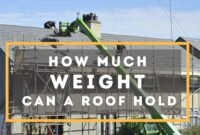In many homes, using a roof drain with overflow is increasingly common. These drains, including their drain bodies, are strategically placed on the roof to channel water from its surface to the water spout efficiently.
The overflow drains are an essential component of this system, designed to handle excess water during heavy rainfall, thereby preventing water accumulation on the roof.
When you live in an area where heavy rain is common, you may want the roof drain to be completed by an overflow feature. What is it, and why you want to use them? Figure out the answer down below.
Roof Drain with Overflow Advantages
Using an overflow can certainly bring numerous advantages. You can read some of the best advantages below, and you will be able to tell why the roof rain must be completed by overflow.

It will also give you insight into how great the drain with overflow is compared to an old-fashioned regular roof drain.
Here is the information for you:
Prevent Flooding on the Roof
The main function of roof rain is to remove water from overflowing the roof. When the water on the roof is overwhelming, the regular drain won’t quickly remove the water.
When you use a roof drain overflow, it effectively manages water discharge, ensuring that the excess water is quickly and efficiently drained away even in heavy rainfall.
This system is particularly beneficial for roofs with limited slopes, where water pools more easily. The overflow drains are an additional safeguard, reducing the risk of water damage to the roof structure.
Provide Additional Drainage
Additional drainage is often needed to ensure the house and roof are safe from the impact of heavy rain. You do not need to add extra drainage as the overflow feature works that way.
The combination of the roof drain and overflow drains is designed to handle a larger volume of water, effectively transferring it down through the spouts. This system ensures that the roof’s drainage capacity is not overwhelmed even during intense weather conditions.
Moreover, installing these drains is typically straightforward, with the drain bodies being positioned at strategic points on the roof to optimize water flow and prevent any potential overflow.
Keep the Roof Structure Sturdy
When the roof is soaked in water numerous times, there is no doubt that the roof will get soiled and eventually break down. A good drainage system will prevent the roof from getting damaged. Use the drain with an overflow feature to keep the water from the roof.
Prevent Soiled and Rusty Pan Roof
The roof is not only made from wood or clays. Sometimes, they are made out of aluminum and other types of metal. When they become overexposed to water due to heavy rain or something else, they will certainly rust or soil. Use an overflow drain to prevent this from happening.
Read also: Flat Roof Leaks in Heavy Rain
Get Water to Flow Faster
The key to having a functional roof is to keep the water down as fast as possible. Even when you use a flat roof, you can get the drain completed by overflow. The roof does not have to be steep to remove the water.
By understanding those advantages, you can tell how beneficial those roof drains are. When you need to get the roof a new drain, you know that you will have to look for the one with extra overflow.
It will prevent the house from getting flooded and keep the roof in its prime condition for many years. This is why everyone needs a roof drain with overflow at home.


